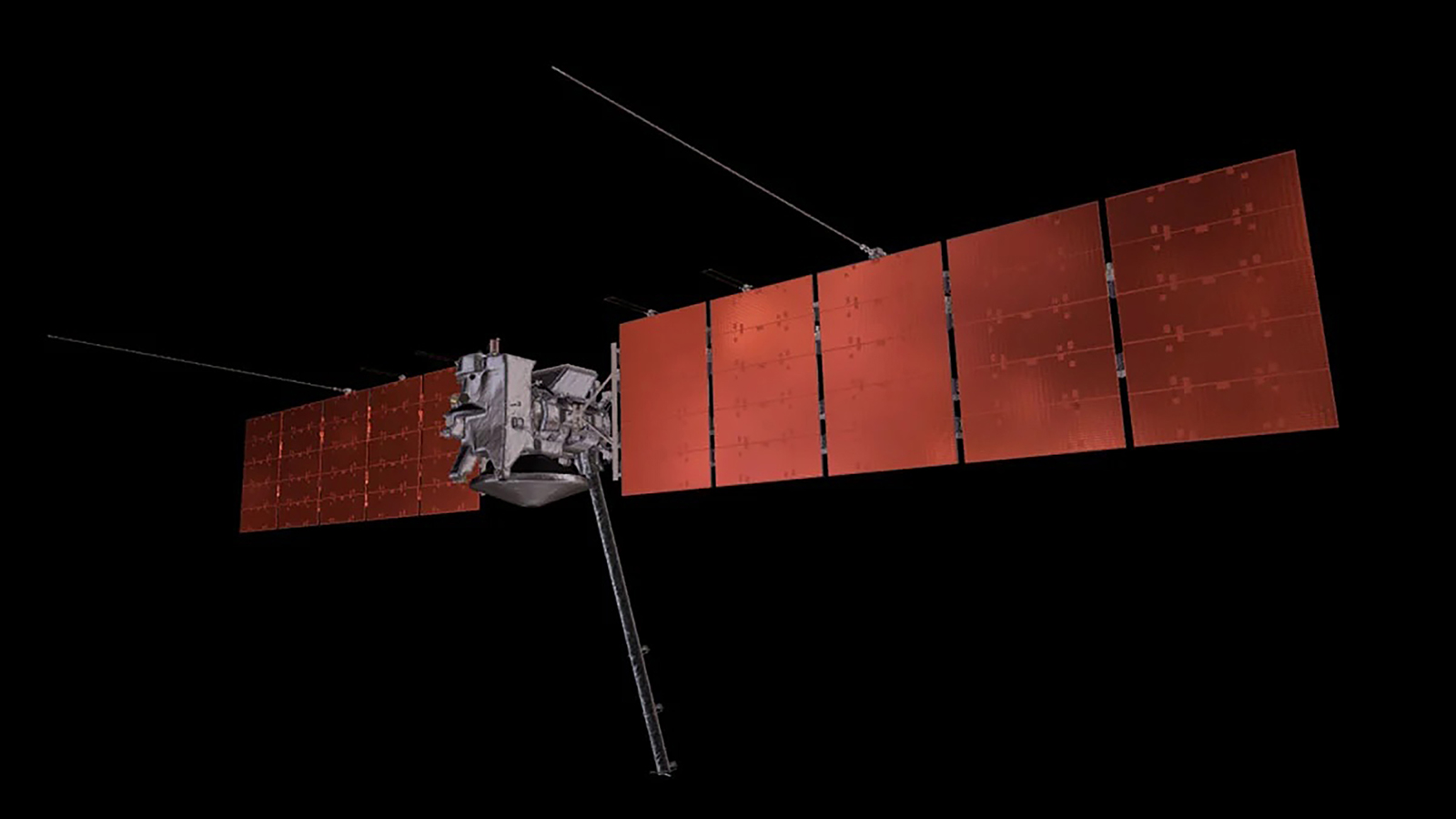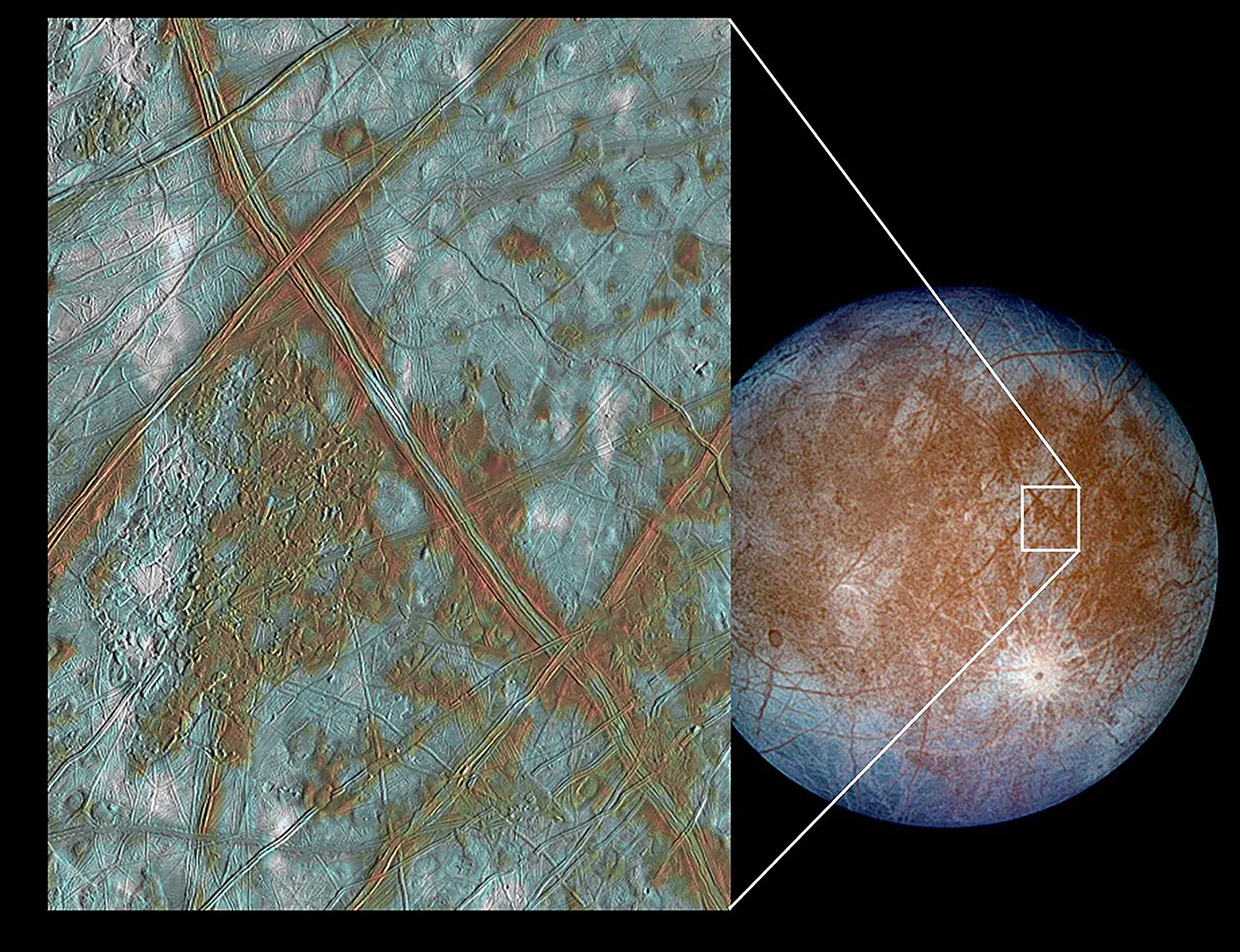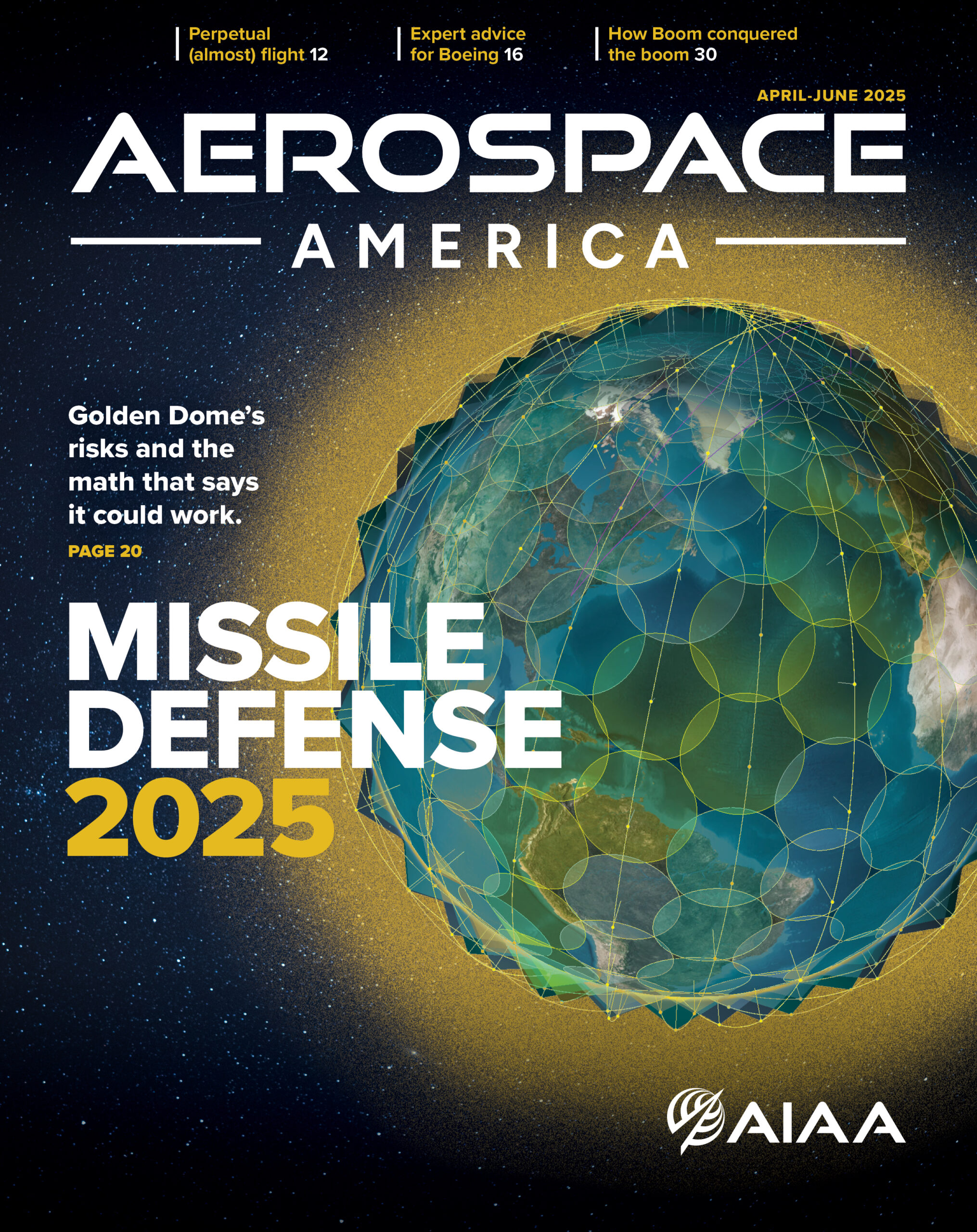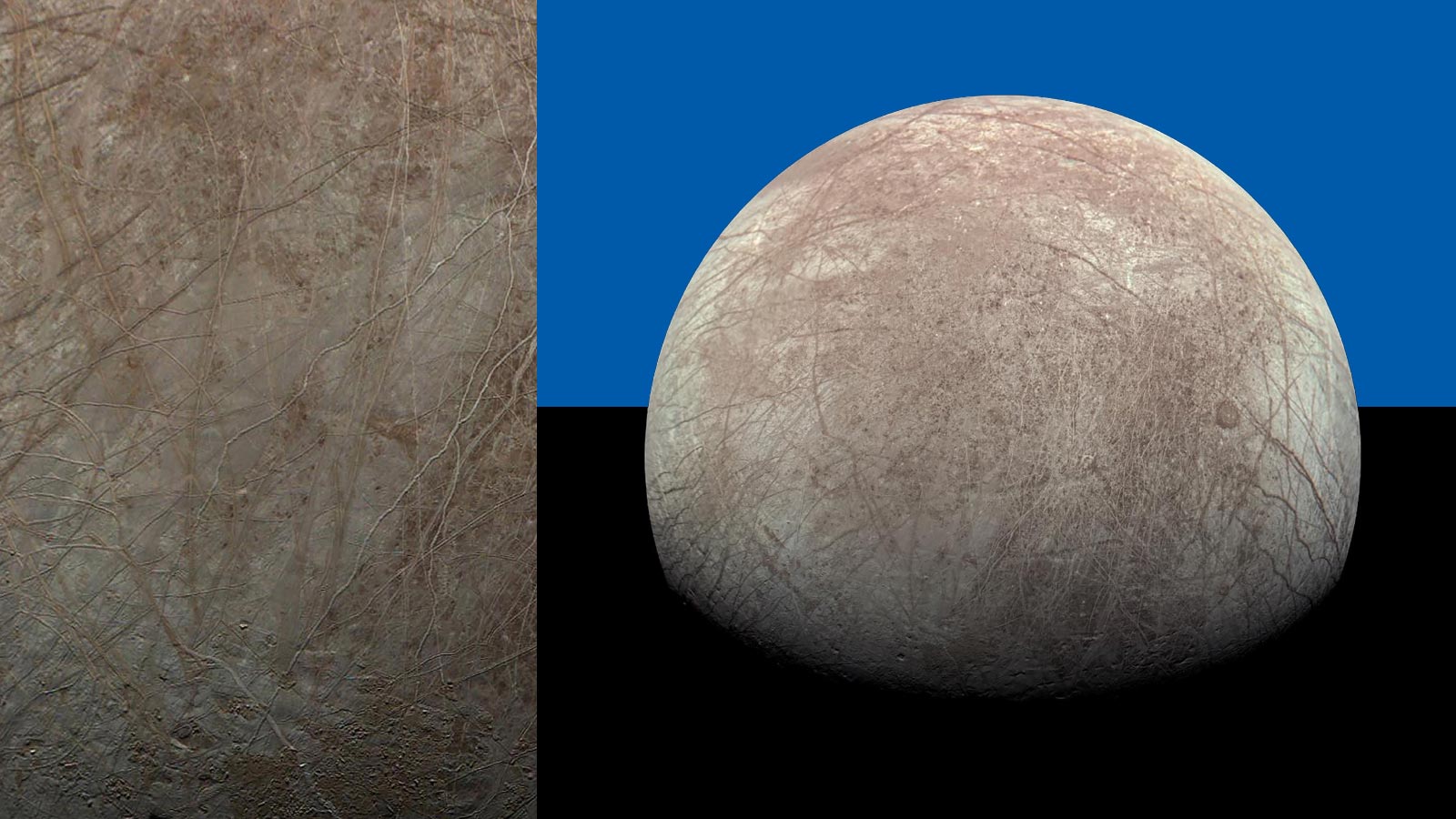Stay Up to Date
Submit your email address to receive the latest industry and Aerospace America news.
While those interested in the question of life beyond Earth were busy parsing data from the numerous spacecraft sent to Mars over the decades, other scientists were advocating for construction of Europa Clipper, an orbiter now awaiting launch on a mission that could determine whether this icy moon deserves to join Mars in the search for life. Jon Kelvey looks at the science at stake as NASA weighs a potential survivability flaw that has complicated this year’s launch plans.
Editor’s note: NASA announced in early September that Europa Clipper is approved to proceed toward launch, with the first opportunity on Oct. 10. Read the latest updates here.
Scientists off the coast of South America in 1977 dropped an instrumented cable overboard down to the Galapagos Rift 2,500 meters below. Conventional wisdom said they would be studying a desert seascape, given that sunlight rarely penetrates deeper than 200 meters and never more than 1,000. Being scientists, they still wanted to get a look at the ocean bottom, so they included film cameras on the cable.
When the first photos were developed aboard the Research Vessel Knorr, the scientists were speechless. An oasis teeming with life came into view: a thriving community of giant clams, octopuses and tube worms, all clustered around a source of hot, shimmering water. They had discovered the first of what scientists now know are hundreds of deep sea hydrothermal vents. Mineral-rich water heated by subsurface magma is spewed back into the otherwise cold depths from these underwater hot springs. Two scientists soon after rode in the deep sea submersible Alvin down to the site and took samples. Biologists later ascertained that bacteria were feeding off the chemical soup streaming from the vent and that all the other life in turn fed on those microbes — life in permanent darkness, no photosynthesis required.
It’s a long leap from the deep sea to Jupiter’s moon Europa, nearly 400 million kilometers away, but two years later, NASA’s Voyager 1 and 2 spacecraft flew by Europa on their tours of the solar system. While the images were not highly detailed, they showed an icy surface with long cracks and conspicuously few impact craters. Scientists published papers arguing that Europa’s surface was relatively new, reshaped by large amounts of liquid water from beneath the surface.
They started to wonder: Could Europa have an ocean under the ice? And if so, could that ocean be warmed by hydrothermal vents like those on Earth?

The next examination of Europa came in 1997, when NASA’s Galileo probe detected variations in its magnetic field that suggested that indeed a large volume of water of unknown chemistry lay beneath kilometers of ice. Galileo also showed the icy, fractured surface in even sharper detail, leading scientists to describe portions as “chaos terrain.” More recently, in 2022, NASA’s Juno spacecraft returned even higher-resolution images that suggested Europa periodically spouts geyser-like plumes of water into space.
Now, this year, Europa could join Mars as a top target in the search for life beyond Earth, a search that in Europa’s case would begin with assessing whether it has the ingredients for life to have evolved.
Awaiting launch and the results of an unexpected last-minute reliability study, is the Europa Clipper. At 6,000 kilograms once fueled, it will weigh as much as an African elephant at launch, and its solar arrays once deployed will span 30 meters, making it the largest NASA planetary probe ever launched. It will need all that power to drive a radar designed to penetrate Europa’s ice to measure its thickness and to drive instruments meant to scan the surface and capture dust and gas particles. This should help scientists determine whether the moon has the chemical ingredients necessary for life of some form to have evolved — in other words, whether it is habitable.
“What are we doing not sending something before now? It’s never made any scientific sense,” says Britney Schmidt, a Cornell University associate professor of astronomy and member of the radar instrument team for the $5 billion mission.
Until now, NASA’s search for life and the ingredients for it has focused almost exclusively on Mars, a much closer neighbor that does not take half a decade or longer to reach and conduct science. Starting with the Mariner 3 attempted flyby in 1964, the agency has sent nearly 30 spacecraft to fly by, orbit, land on or rove across Mars — often sending multiple spacecraft simultaneously.
NASA still lists the launch window for Europa Clipper as opening Oct. 10. But when this article was completed in mid-August, scientists were awaiting the results of a study that was to be completed by the end of the month into the last-minute discovery of a possible vulnerability to radiation within semi-conductor transistors that control the flow of power to the spacecraft’s electronics. Those electronics must survive 50 close flybys of the icy moon as the spacecraft orbits Jupiter and dips into or “clips” the moon’s lower atmosphere, then quickly retreats out of the punishing radiation.
If all goes as scientists plan, they could accomplish for Europa science in four years what took NASA six decades and more than a dozen missions to do for Mars: Characterize the currently unknown geological processes that shape its surface and interior, and analyze the moon’s geochemistry to see if the right mix of chemicals is present to suggest it is habitable.
“We are in a Mariner phase — this is how I compare things,” says Nathalie Cabrol, an astrobiologist and director of the Carl Sagan Center for Research at the SETI Institute, referring to the NASA planetary probe program of the 1960s and early ’70s that managed to orbit or fly by Mars in four of six attempts. With Europa Clipper, “we are going to get the data that helps us build this mental map of what’s out there. But the difference is now we know how to do this better, faster.”
In the context of this mission, habitable means looking for signs of the three things thought necessary for life to form, based on what’s known about the process on Earth: Those things are “liquid water, energy and something to eat,” says Bonnie Buratti, deputy project scientist for Clipper, who in July gave a lecture about the mission during AIAA’s ASCEND conference in Las Vegas. (Project scientist Robert Pappalardo told me in an email that Buratti was the right person to talk to, as he was busy with mission preparation.) On Earth, it was once thought life must have started only in shallow seas, where elements like carbon, nitrogen, oxygen and sulfur — energized by the sun and perhaps lightning — combined to form amino acids, the building blocks of DNA and all terrestrial life. But the discovery of hydrothermal vents presented an alternative or additional route, in which life could take root by drawing on thermal instead of solar energy, and feeding off chemical-rich vent outflows.
And if life could have arisen in the deep sea on Earth, Buratti says, maybe it could have on Europa or on Saturn’s icy moon Enceladus, which NASA’s Cassini probe in 2015 confirmed harbors a subsurface ocean.

“That’s the whole scientific basis for the Europa Clipper mission: to search for a habitable environment on an ocean world,” she says.
Clipper could confirm the existence of Europa’s ocean and detect and analyze water and chemicals carried up to the surface that suggest the moon contains hydrothermal vents and habitable conditions. But detecting alien microbes or even amino acids will fall to a follow-up mission — possibly a lander that would sample ocean water seeping to the surface or somehow melt through the ice to reach the ocean directly. On Europa, definitively discovering alien life won’t be easy, Cabrol says, because the biology could be so different from life on Earth. The only easy case be would the discovery of complex organisms, animals, like those found around Earth’s hydrothermal vents.
Unless the Europa equivalent of a “white rabbit” jumps in front of the lander, “we are not going to be able to understand if what we see is life or not,” Cabrol predicts. While she doesn’t seriously conceive of Europa hosting animals, she says, if a future mission manages to lower a camera beneath the ice and surprises scientists with images of Europan fish, “I would love that.”
But theories about complex organisms on other worlds can only be speculation for now, according to Buratti. “We don’t have enough evidence because we haven’t found life anywhere outside of the Earth. So we have no data points on which to base our ideas,” she says. On Europa, “we believe we are seeking primitive life.”
“Europa is a hard target,” says Princeton astrobiologist Christopher Chyba. To determine habitable conditions, scientists would ideally like to measure and sample some of the ocean, but “the ocean is under kilometers of ice, and anything that’s come up to the surface has been pelted by Jovian radiation.” That means that most complex organic molecules won’t last long if they do reach the surface, and Clipper would have to detect them before they’re literally shredded by high-energy electrons whipped by Jupiter’s massive magnetic field.
“If you put a plastic bottle of water there, it will probably be gone in a couple of days,” says Mikhail Zolotov, a University of Arizona planetary geochemist who’s a co-investigator on several of Clipper’s instrument teams. “The surface is definitely not habitable because it’s like a Chernobyl.”
With Clipper’s radiation-mitigating flight path, it will need to capture as much information as possible in each pass. The spacecraft’s instruments are designed to act in a concerted, overlapping fashion, hopefully allowing them to record any surface changes that could indicate areas where the subterranean ocean is welling to the surface through cracks in the ice.
“We have 10 different science investigations, and they’re all working together to look at the same place on Europa at the same time,” says Ingrid Daubar, a Clipper project staff scientist and Brown University planetary scientist.
For instance, while the Europa Imaging System (Clipper’s pair of optical cameras) work together to capture 90% of Europa’s surface at a resolution of 100 meters per pixel — five times the resolution of Galileo — the Mapping Imaging Spectrometer for Europa will determine the chemical composition of the same terrain captured in those images.
One unknown variable that could help or hinder Clipper’s mission is the structure and depth of Europa’s icy crust. The REASON instrument, short for Radar for Europa Assessment and Sounding: Ocean to Near-surface, will beam two radio signals into the ice. The 5-meter wavelength signal must penetrate a few kilometers into the ice to probe its structure and detect any hidden pockets of melted ice, while the 33.3-meter wavelength signal will attempt to probe as deep as 30 kilometers into the ice, and perhaps confirm the existence of a subsurface ocean.

But if the ice shell is too deep, Daubar notes, the radar may not penetrate deeply enough to detect an ocean. Different models of Europa’s ice have differed on this point.
Europa Clipper scientists, including the project scientist Pappalardo, have long argued the ice is likely at least tens of kilometers deep, possibly deeper. Richard Greenberg, a planetary scientist who worked on the Galileo mission imaging team, argues that the ice could be much thinner.
“The most plausible interpretation of the features observed on the surface of Europa (tectonics and melt-through areas) is that the ice is thin enough for direct connections between the ocean and the surface,” Greenberg tells me by email, “which means less than 10 kilometers.”
A thinner crust with direct connections to a subsurface ocean could increase the chances of water seeping to the surface, where Clipper’s spectrometer could analyze it for chemical signs of habitability. Meanwhile, the Europa Thermal Emission Imaging System will look for relative hot spots “where maybe there’s some warm, mushy ice or even some upwelling from below,” Daubar says. Such locations would be prime targets for any future lander mission, which could sample and analyze the liquid for signs of habitability or even the presence of life.
If the scientists get very lucky, Clipper might document plumes of water erupting from Europa, as Cassini did at Enceladus. Clipper carries two instruments that can capture and analyze the chemical composition of the material if the spacecraft flies through them.
And if it does exist, Europa’s ocean could likely be weird compared to Earth’s. There are many possibilities besides a salty ocean that fit what scientists know about Europa so far, Zolotov says, such as a soda ocean in which dissolved sodium bicarbonate predominates. Or it could turn out to be what Zolotov describes as a “cooked comet” — a thick mass of organic compounds more like glittering oil or waxy paraffin.
“It will be this mess: salt rich, soda rich, organic rich,” he says, the consistency of chicken soup. “At the top, it would be like organic goo and water.”
A gooey ocean might fit with other ambiguous signs of habitability that Clipper uncovers. On the other hand, Zolotov says, Clipper could make discoveries that definitively rule out Europa as habitable. For example, if observations and measurements of the atmosphere and any plumes indicate that the ocean consists largely of sulfuric acid or contains large amounts of mercury fluoride or hydrogen peroxide, those chemicals would “sterilize any cell,” he says. Hydrogen peroxide is already known to exist on Europa’s surface, he adds, the result of water being bombarded by Jupiter’s radiation.
Whether Clipper will provide definitive answers as to Europa’s habitability depends on what surprises the moon has in store. If Buratti had to guess, “The results are likely to be ambiguous.” Her prediction: “We’ll find all these elements and say, ‘Yeah, there’s a habitable environment there, but it’s iffy.’”
But there are some things Clipper should be capable of detecting that would make habitability extremely likely, she says. If Clipper discovers a salty ocean with traces of chemicals that suggest the presence of hydrothermal vents, as well as organic molecules such as polycyclic aromatic hydrocarbons, long chains of carbon rich molecules, “I think that would clinch it.”
Such a discovery — on Europa, Mars or anywhere else — would likely set off a debate over how to prioritize the research that follows.
Mars is more accessible, and optimistically speaking, humans might visit within a decade, which could put the definitive answer of whether life has ever existed there within reach. But Martian life could be less interesting, notes planetary scientist Chyba, since it may have arisen in a similar way to life on Earth or even have been seeded by terrestrial life by an ancient exchange of meteorites.
“If there’s life on Europa or Enceladus, it’s probably due to a separate origin,” he says, even if there are vents bearing some resemblance to those on Earth. “From a scientific point of view, that’s of greater importance.”
At the same time, the similarities between ancient Mars and Earth offer an opportunity that Europa does not. On Earth, plate tectonics drove most of the planet’s earliest crust into its hot mantle through plate subduction over billions of years, carrying with it any record of Earth’s earliest biochemistry, according to Cabrol. Whereas on Mars — a nearly dead planet geologically — the genesis of any life might have been preserved, she says. Therefore, any discovery of life on Europa shouldn’t mean abandoning the search on Mars.
“Mars might still be the Rosetta Stone for us to understand who we are, how it all happened,” Cabrol says.
A discovery of alien life on the red planet or Europa would require NASA to do the same risk and reward analysis as it always does for new missions, trying to do the most it can with the resources it has. But it certainly won’t stop astrobiologists from looking everywhere in the cosmos for signs of life, according to Schmidt, the Cornell professor.
“If we find life on Mars, I’m happy to just sleep in the next day and then go back to work. Same thing if we find life on Europa — I’m throwing a party, and I might take the week off,” she says. “And then I’m going back to work because it’s still fascinating and we need to understand it.”
When the Clipper almost had a companion
Today’s Europa Clipper plan marks a return to a step-by-step approach for getting to know this icy moon of Jupiter, after the demise of a short-lived plan to send a lander along with it. The origins of this bolder plan can be traced to 2014, when then-Rep. John Culberson (R-Texas) became chair of the House subcommittee that recommends appropriations for NASA. His district spanned parts of Houston and its suburbs, home to many space professionals and enthusiasts. At the time, NASA’s Jet Propulsion Laboratory in California was carrying out a baseline plan to send a spacecraft into an orbit around Jupiter that would take it repeatedly by Europa. This spacecraft would follow up on a stunning finding from the Galileo probe nearly 15 years earlier: Its magnetometer had spotted changes in Europa’s magnetic field that indicated that enormous quantities of an electrically conducting material, meaning liquid water, lay beneath the surface.
Without closer measurements of Europa, it was impossible to confirm the existence of this subsurface ocean. “But the evidence was mighty compelling,” Margaret Kivelson, who was principal investigator for Galileo’s magnetometer, told me in 2016.
Culbertson’s view was that scanning such a fascinating world from a distance was no way to demonstrate U.S. leadership in science. He made his point with humor: “There might be some frozen shrimp or frozen krill or who knows what else in that frozen snow.”
The possibility of life in some form remains no joke. Culberson succeeded in passing legislation that directed NASA to send “an orbiter with a lander” to Europa and launch them “no later than 2022.” To help win Senate approval, NASA would need to launch the lander and orbiter on a Space Launch System rocket. SLS construction was managed at NASA’s Marshall Space Flight Center in Alabama, home to Republican Sen. Richard Shelby, then an influential member of the Senate Appropriations Committee and later its chair. More reason for scientific excitement came in September 2016, when NASA reported that the Hubble Space Telescope had spotted what may be plumes of water rising 200 kilometers into space from cracks on Europa’s surface.
Behind the scenes, however, there remained some realists who wondered about the wisdom of building an orbiter and lander at the same time. “I worry that we are right back where we were with an unaffordable mission,” one scientist told me at the time, asking not to be named discussing internal deliberations. An initial 2009 Europa mission concept hadn’t gained traction due to its multibillion price tag. As for the bolder plan, in 2016 the Government Accountability Office estimated that just the orbiter portion would cost $3 billion to $4 billion. Others wondered how a lander could be designed appropriately before anyone knew in detail what the landing surface would be like.
The lander-orbiter plan didn’t last long. The first blow came in 2018 when Culberson lost his reelection bid. Then, the lander was dropped when Congress did not provide funding for it in the 2021 budget. For now, supporters will need to be content with an ongoing lander study by NASA and with the upcoming launch of Clipper. That launch, possibly in October, depends on the outcome of a last-minute study of Clipper’s vulnerability to radiation and what if anything can be done if the risk is unacceptable. Right now, the estimated mission cost stands at $5 billion, and the SLS launch directive was abandoned long ago. Clipper will go up on a Falcon Heavy. — Debra Werner
About jon kelvey
Jon previously covered space for The Independent in the U.K. His work has appeared in Air and Space Smithsonian, Slate and the Washington Post. He is based in Maryland.
Related Posts
Stay Up to Date
Submit your email address to receive the latest industry and Aerospace America news.




